As artificial intelligence continues to evolve, developers and businesses are turning to powerful tools like ChatGPT (GPT 4.1) to create intelligent, human-like agents capable of executing complex tasks. These agents can handle customer service, automate workflows, and serve as personal assistants. With the latest iteration of OpenAI’s language model, GPT 4.1, building AI agents is more efficient, scalable, and accessible than ever before.
Understanding AI Agents
An AI agent is a digital entity that can perceive its environment, understand context, and perform goal-oriented tasks using artificial intelligence. Powered by LLMs (Large Language Models), such as GPT 4.1, these agents go beyond chatbot functionality and are capable of interacting with APIs, retrieving external data, and reasoning through problems with context-aware logic.
Getting Started with GPT 4.1
Building an AI agent using ChatGPT begins with understanding the capabilities of GPT 4.1. This version includes enhanced reasoning skills, faster response times, longer context windows, and better tool integration. The process of building an AI agent involves several steps:
- Define the Agent’s Purpose: Clearly outline what goal the agent needs to achieve — from managing calendar events to performing sentiment analysis.
- Design the Workflow: Sketch how the agent collects inputs, processes data, and delivers outputs. This might include API calls or integrating external tools.
- Use a Platform or SDK: Tools like OpenAI’s function calling, LangChain, and Auto-GPT allow developers to build structured interactions with large language models.
- Implement Memory and Context: For agents to engage in meaningful, ongoing interactions, they must retain and manage context using retrievers or vector databases like Pinecone or FAISS.
- Deploy and Monitor: Once the agent has been built, test it thoroughly and monitor performance using error logging, feedback loops, and analytics.

Key Components of an AI Agent Using GPT 4.1
When constructing an AI agent, taking advantage of GPT 4.1’s advanced features can significantly improve outcomes. The following elements are critical:
- Function Calling: GPT 4.1 allows dynamic calling of internal or external functions during a conversation. This enables the agent to perform tasks like pulling weather data or processing a payment.
- Long-Term Memory: Persistent memory allows the agent to hold onto user preferences, project progress, or frequently accessed information.
- Tool Usage: Integration with tools such as browsing, code execution, or databases empowers the agent far beyond traditional dialogue systems.
GPT 4.1 is designed to handle much longer context windows, making it suitable for agents that need to remember more details throughout a session. Combined with knowledge retrieval systems, it creates more versatile and intelligent AI ecosystems.

Top Use Cases for AI Agents
With ChatGPT capabilities, AI agents can be developed for a diverse range of applications, such as:
- Customer Support Assistants: Handle user queries, automate ticket triage, and escalate complex issues when necessary.
- AI Tutors: Provide interactive learning sessions by breaking down complex topics in a personalized way.
- Project Management Helpers: Plan tasks, summarize meetings, and suggest actionable tasks based on conversations.
- Data Analysts: Query databases, visualize information, and create easy-to-read reports via natural language.
Best Practices
- Start Simple: Begin with a basic task and incrementally add complexity.
- Use Clear Prompts: Well-crafted prompts guide the model more effectively and reduce ambiguity.
- Monitor Usage: Analyze how users interact with the agent to identify improvements and ensure accuracy.
- Secure APIs: Make sure the agent interacts securely with any third-party services and doesn’t expose sensitive data.
Conclusion
Building AI agents with GPT 4.1 opens new doors in automation, productivity, and innovation. Its capabilities make it easier than ever for developers and businesses to deploy intelligent systems that communicate naturally, adapt to various roles, and continuously improve. With smart design, practical implementation, and proper tooling, AI agents powered by ChatGPT can significantly enhance user experiences and operational efficiency.
Frequently Asked Questions (FAQ)
- Q: Do I need to be a developer to use GPT 4.1 for building agents?
A: While technical knowledge helps, several tools like OpenAI’s playground, Bubble, or LangChain offer low-code/no-code options for building functional agents. - Q: Can GPT 4.1 agents perform real-time actions?
A: Yes, using function calling and API integration, agents can interact with live systems such as calendar apps, email platforms, and databases. - Q: How do agents store long-term memory?
A: Agents use external memory systems like vector databases (e.g., Pinecone) to store and retrieve contextual information based on semantic similarity. - Q: Is it possible to customize the tone and personality of the agent?
A: Absolutely. GPT 4.1 supports system-level instructions that define how the agent should talk, behave, and react. - Q: What are some good libraries to start building AI agents?
A: Popular frameworks include LangChain, Auto-GPT, GPT-Engineer, and Semantic Kernel, all of which help streamline agent logic and state management.
